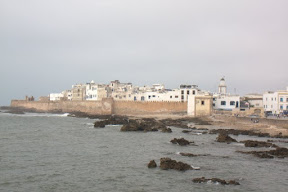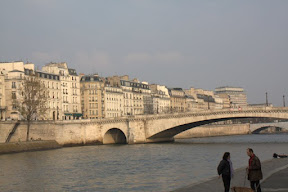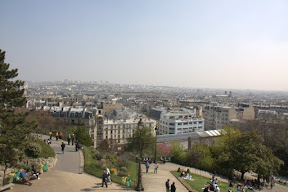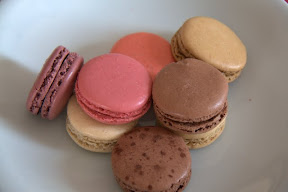Toto, I’ve a feeling we’re not in Paris anymore.
On April 26, we bid our friend Matt and the comforts of Paris adieu and flew to Essaouira, Morroco: a new city, new country, new continent.
We didn’t so much land in Morocco as we were hurled into Morocco. It was as if the pilot suddenly thought, oh crap, here’s our destination, and pointed the plane straight down, straightened out in time to barrel down the runway, and slammed on the brakes when he ran out of road. As soon as the plane screeched to a halt, and everyone wiped the shock off their faces, the passengers exchanged glances, with thoughts like, So how about that? We’re still alive.
Our arrival was symbolic of our time in Essaouira. Along with two Parisian girls, we took a taxi from the airport (which consisted of one runway, a customs office, and…well, that’s about it) to the medina of Essaouira. In many Moroccan cities, the heart is still within their medinas, and Essaouira is no exception. A medina is a section of the city enclosed and surrounded by walls, with souqs (shops) and riads (buildings with an internal courtyard) tucked inside.
Located on the coast of the Atlantic Ocean, Essaouira is famous for its fierce winds, which were exacerbated by the taxi driver’s insistence upon driving what felt like 100 mph. Sean and I once had a wild cab ride in New York City, where a driver got us across town in about 3 minutes flat, but the Moroccan cab driver made the NYC cabbie’s style seem more akin to a Sunday drive with your grandparents. The Moroccan cab driver insisted upon being first on the roads, which apparently required getting about an inch away from the other cars, trucks, horses, and scooters, and then whipping around them on the left. I’m told by Sean, who was sitting in the front, that we passed rows of other cars completely blindly. I wouldn’t know, because I was too busy ducking in the backseat to hide from the wind belting through the open windows.
 |
| From Essaouira |
Even though we negotiated a 10 euro fare with the driver at the airport, upon arrival, he insisted we owed him more. We insisted we didn’t, and considering we had no more Euros, we prevailed. We also didn’t have any dihrams, the Moroccan currency. We gave an American five to the cabdriver, who finally accepted it and drove away. We entered the medina, without any dihrams and without a complete map. He doesn’t speak the language…he holds no currency…
We’re told by our guide book that Essaouira is more laid-back than other Moroccan cities. If that’s true, we’re screwed. As we wandered through the medina, trying to find our hotel, I laughed, recalling how we felt so disoriented in a French bakery only two weeks before. A bakery, for crying out loud. With our confused looks and backpacks, we attracted touts wondering if we needed a place to stay? Directions to our hotel? Good price on spices/pottery/carpets/shoes? Even if we wanted any of those things, we did not yet have any dihram, because there was no currency exchange or ATM at the “airport.” Sean’s attempts to exchange money in advance failed because dihrams are a closed currency, which means they cannot leave the country. One man was particularly insistent, and followed us for at least ten minutes. We tried ignoring him. We tried telling him directly, no thanks. Neither approach worked. Every time we thought we lost him, he popped up again, saying, Hello. Bonjour. Sure you don’t need a place to stay? It is very nice. I will give you a good price. At one point, behind us but hurrying along to stay by our side, he started spouting off in Italian. You know Italian? I know Italian. [Insert random Italian here]. See, I know Italian. Fuggetaboutit!
I’m not sure how we finally lost him, but when we finally found our hotel, exhausted, sweating, I was shaken. Not scared, but anxious. The feeling remained for two days straight. Although I read countless blogs, talked to various people, read many guidebooks, nothing can quite prepare you for this. The touts are more persistent and more aggressive in real life than I ever thought. I have no idea who to trust, because I assume everyone wants something. The smell – oh the smell – is more constant, more putrid, and more disgusting than I ever imagined. The sight of the stray cats around every corner makes me sad. At first, I am charmed by them, until I realize that most of them are sickly and mangy and look like a cat a friend once nicknamed Death. The sight of people – really, really poor people – begging you for what amounts to about 10 cents is harder to ignore than I think I can stand. I feel overwhelmed, and for one of the first times since leaving work, I get a migraine. The thought creeps in, way in the back of my mind, that maybe this isn’t so great after all, and maybe, just maybe, we aren’t cut out for this.
But then I see tourist families, with small children skipping down the street, who are relaxed and having fun. I see friendly people, whose whole lives depend on the tourist economy, who warmly tell us, welcome. I remember that I am fortunate to grow up in a country like the United States, and that real, actual people live here, every day. I start getting used to our surroundings, and by the third day, I don’t feel so anxious anymore. I begin enjoying certain aspects of Essaouira, such as the bustle at the busy working harbor or the flocks of seagulls, who fly gracefully through the sky above the water. The seagulls fly in tandem. They are inches away from us, close enough to see their wings outstretched and feet tucked up behind them. We ride camels named Cappuccino and Zerban on the beach. We chat with a fishmonger over lunch, which consists of fish caught less than an hour before and grilled in front of us. During lulls in business, we hear him singing, If you liked it you shoulda put a ring on it… We walk along the beach, and watch the soccer games playing out on the sand. We enjoy our dinners, the first at a restaurant with a French influence, the second traditional Moroccan, or the third in what could have been a funky loft in Soho. We enjoy the solace of our room, especially once we upgrade to one with a view of the ocean crashing against the rocks.
We’re in Marrakesh now. I’m happy to report that our rattled nerves in Essaouira must have been a combination of adjusting to travelling in a completely foreign land and something about Essaouira not being for us, as we both got an instant good feeling about Marrakesh. More on Marrakesh to come…
The Big Five
This past weekend, Matty, Sean and I took a train from Paris to Brussels, Belgium. We had five goals for our weekend in Belgium, much like those who are on safaris in Africa: to drink Belgium beer and to eat moules, frites, chocolate and waffles, not necessarily in that order. We accomplished our goals quite nicely.
In short version, our weekend could be summed up as beer, beer, moules, frites, beer, beer, beer, waffles, beer, chocolate, chocolate, chocolate, beer, frites, and waffles. (That’s leaving out the absinthe and Grec in which Matt and Sean decided to partake after I went back to the hotel to go to bed after we had been drinking for 10 hours straight). Before we left, during my negotiations with Sean in the middle of Target about which over the counter medications that were necessities, we debated the finer points over whether Pepto Bismal was different than Immodium. In the end, only Immodium made the cut, but on the train ride back from Paris, I recalled the main difference between the two. Pepto Bismal lists “overindulgence in food and drink” as one of the conditions it treats. Sean kept asking me what was wrong on the train, and I moaned, Overindulgence in food and drink…Overindulgence in food and drink…
In the somewhat longer version, our weekend to Brussels was a lot of fun, but we all concluded that one weekend in the city was enough. (Although Matt repeatedly mentioned, usually at a café sampling various Belgium beers and lambics, each in their own uniquely shaped glass, This would never get old. I could do this all of the time!) When asked about his experience visiting Brussels before we left, our friend Brad, who opted not to go with us, only said, Brussels is…interesting. You’ll see.
If Paris is refined, uptight, and classy, Brussels is coarse, bawdy, and quirky. The language in Brussels is somewhat of a hodgepodge, with French spoken mostly, with some English, Flemish and Dutch thrown in. The French influence tricks one into thinking the city is like Paris, but you quickly learn that it is not. For one, the café culture is ubiquitous, but completely different than Paris. I saw no one sipping mineral water or espresso in Brussels. Instead, everyone was drinking some form of beer. People were seated around café tables, instead of lining up in the stadium style seating like they do in Paris. I didn’t realize how immaculate Paris’s streets and landscaping are until viewing the graffiti and litter present in Brussels. Many stores were closed in Brussels, and the empty streets felt like downtown Pittsburgh on a weekend. While Paris allegedly has a lot of immigrants, one rarely sees them, but some of the neighborhoods we walked through in Brussels felt like we were in the Middle East, with children climbing on a mock camel and women in traditional garb. The most obvious example of the differences between Brussels and Paris is Brussels’ main tourist attraction: the Manneken Pis, a statute of a little boy peeing. Manneken Pis also has companion statutes elsewhere in the city: one of a girl squatting and one of a dog lifting his leg. Nice.
Even if Brussels is a little on the raunchy side, raunchy can be kind of fun. For one thing, there’s the beer. We visited Delerium Cafe, a place Matt dubbed “The Disneyland of Beer.” The bar had rows of copper taps, with endless amounts of Belgium beer to try. After all, one grows weary of drinking wine all of the time in Paris.
As for Manneken Pis, his “Friends of Manneken Pis” take him very seriously, and we were lucky enough to witness the changing of his outfit, a regularly scheduled ceremonious event.
When we passed by the statute again later in the day, people in brightly colored costumes danced and sang, while the woman who changed his outfit earlier stood in the fountain, holding up shot glasses to the “pee” stream. The “pee” was now some sort of alcohol instead of water, which lucky recipients in the crowd received. Meanwhile, a man with a serious mustache pushed around a cart with a replica of the pissing boy leering down at the crowd. To clear the street of people, he lurched the cart forward, sending “pee” through the air towards unsuspecting bystanders.
Brussels wasn’t all raunch and debauchery. The Grand Place, a UNESCO World Heritage site, is a site to behold with its Gothic architecture surrounding you on all sides. We had lunch consisting of fancy salads and pasta on a street filled with cute little cafes, interspersed with art galleries.
Brussels also has, of course, some of the world’s finest chocolatiers. The chocolatiers turn chocolate making into a fine art, like the creation of wine or cheese. I think it was the chocolates that blew our budget for the day, but tasting some of the world’s finest chocolates was worth it. Since I don’t discriminate in my chocolate (Sarris or Hershey, I won’t turn either down), I was curious to try the Belgium variety, most of which are handmade.
We visited what according to my research are the top three chocolatiers – Pierre Marcolini, Neuhaus, and Wittamer. I also visited the mass-produced Leonidas for good measure, where I got three filled chocolates for the price that I paid for one at Neuhaus.
In Wittamer, the woman behind the counter waived her hand towards bars of solid chocolate, saying, Here is the dark chocolate. She continued, wrinkling her nose, And here is the milk chocolate, for the Americans. I laughed to myself, and promptly purchased my favorite – the milk chocolate of course – along with some filled pieces of dark chocolate. I certainly would never turn down any dark chocolate offered to me, but none of the dark chocolate I’ve had in the United States could compare to the flavor and creaminess of the milk chocolate. Further taste testing revealed that I could change my milk chocolate eating ways pretty easily if I lived in Belgium, particularly if I directed my chocolate eating towards Pierre Marcolini.
We were told in Pierre Marcolini that Pierre himself hand selects all of the beans. The labels list the origin of the beans, specifying whether the chocolate was made from blended beans or from pure origin. While many of the other chocolatiers focused upon creating different types of filled chocolates, Marcolini mostly featured solid bars of chocolate, with no nuts, creams, or jellies to interfere with the tasting experience. Hands down, the three solid chocolate bars I got from Marcolini were leagues above any other chocolate I’ve had in my life, and better than the other chocolates I purchased that day.
Since you can take the girl out of America, but you can’t take America out of the girl, my favorite was Java Lait, a chocolate featuring beans solely from Indonesia that contained 50% cocoa, cane sugar, soy lecithin, and Tahitian vanilla pods. My second favorite was the limited edition dark chocolate I purchased, with beans from Oriente and Cuba, containing a minimum of 78% cocoa. Its ingredients are cocoa mass, sugar, cocoa butter, soy lecithin, and natural vanilla. Following closely behind was the Chocolat Au Lait, which contains 35% cocoa, “a lightly caramelized milk powder with a subtle taste of honey”, cane sugar, soy lecithin, and Tahitian vanilla pods. Note the complete absence of high fructose corn syrup, and other names you can never pronounce.
All of the chocolate was fantastic, but Pierre Marcolini was the clear winner (and naturally, the most expensive, at 80 grams of chocolate priced between approximately 9-13 US dollars). Behind Marcolini was Neuhaus, and Wittamer, the chocolatier with the snide comments about Americans’ chocolate palette, trailed behind. Leonidas, the mass produced chocolates, were definitely good as well, although I didn’t purchase enough to rank them with the others.
We also stumbled upon a lambic tasting tour that featured pairings of regional, natural cheeses. We planned to tour Cantillon which is the only brewery tour offered in Brussels. They have been brewing lambics there, in the same way, since 1900.
We paid for our tour, and were told we would get two free samples at the end. Walking through the brewery, we noticed people drinking and eating. As we stood there, trying to figure out what was going on, a guy behind one of the stations laughed, and said, Guess you are wondering why everyone has little glasses and you don’t, huh? Why, yes, that is exactly what we were wondering.
After paying some more money, we were allowed to join the tasting, which turned out to be one of the best parts of the weekend. Matt’s brother-in-law Dennis dabbles in beer and wine making, and is an expert in the different types of beer and wine. He told us we had to try to lambics while we were in Belgium, because they are only produced there due to the prevalence of a certain type of wild yeast and bacteria. And try lambic we did. At the tasting, we got to try 16 different types, from a young lambic, to an old lambic, to a young gueze (a blend of different Lambics), to an old gueze, to a kriek (with sour cherries), to framboise (with raspberries), to a pale-ale type Lambic, to a vigneronne (with Muscat grapes), to Zwanze (with elderberry flowers) to Faro (with brown sugar candy). We’re told by Dennis that most of these lambics are not available in the United States, and to the extent that they are available, they would cost about $120 a case.
All of the lambics had a somewhat sour taste that was strangely delicious. The cheeses ranged from creamy and delicious, to extremely pungent, but you couldn’t deny that each cheese was perfectly paired with its lambic companion.
My favorite was the Lou Pepe Framboise (very different and less sweet than the more mass produced Lindemanns Framboise; it is made by blending lambics from the same brewing season with a high level of raspberries and inducing secondary fermentation by using a limited amount of liqueur; paired with Delice des Bois cheese, which is a triple cream cheese stuffed with stewed forest berries). Matt’s favorite was the Cuvee Saint-Lamvinus (a rare and unique beer produced using Merlot grapes soaked in Lambic aged 2-3 years in barrels from the Bordeaux region of France; bottled without any blending and carbonation induced by adding liqueur; paired with sausage with Boletus mushroom) and Sean liked the Cuvee St-Gilloise (a beer produced using cold-hopped Lambic aged 2 years, which brings out flavour and gives it a more bitter aroma and palate; paired with Trappe d’ Echourgnac, which is a cheese made from cow’s milk produced in the tradition of Cistercian monks and matured with walnut liqueur).
Needless to say, whether it was the 16 lambics, or the high alcohol content of the Belgium beers, but we had a grand time in Brussels.
Au Revoir, Paris.
 |
| From Paris by day |
From the time we stepped off the train a little over two weeks ago, Paris has been disorienting. Like many big cities, it is loud, crowded, hectic. Further complicating things is the fact that Paris is in France. Our friends working in Paris told us that up is down in France and down is up, and not to question why. (This hasn’t stopped us from questioning why the light switches turn out upside down, why the spin cycle on the washing machine only actually spins every couple minutes, or why two light switches need to be in the correct position to turn on the overhead light). Every time we go into our favorite bakery around the corner, we feel like the people using cash who interrupt the flow in that credit card commercial. We stand there, debating our choices, while the other customers sail in and out. The girl behind the counter eventually gives up on us and walks away. When we finally make our selections, we awkwardly order. Meanwhile, the cashier continually calls out in a sing-song voice, Bonjour! Merci Beacoup! Baguette! Madelienes! Mer-ci Bea-coup!
I liked Paris from the start, but I couldn’t say it was love at first sight. Sure, I thought, Paris is a nice city, but what makes it different than any other big city? Initially, the highlights of Paris were seeing our friend Matt and Sean’s friends from work and the hairdryer, heated towel rack, and washing machine in the apartment.
We filled our days with all that Paris has to offer.
We admired the very tall stained glass windows at 13th century Saint Chappelle.
 |
| From Paris by day |
We viewed the flagrant flaunting of royal opulence outside the city at Versailles.
 |
| From Versailles |
We gazed at the Eiffel Tower sparkling in the distance at night.
| From Paris by night |
We walked down Champ Elysses to the magnificent Arc de Trimoph, and strolled along the river by Notre Dame.
 |
| From Paris by day |
 |
| From Paris by day |
We had a picnic at the Eiffel Tower, surrounded by spring flowers. (And very aggressive French ducks).
 |
| From Paris by day |
We viewed Paris from up on high, from Montmarte and Printemps.
 |
| From More Paris… |
| From More Paris… |
Sean went to the Louvre, and Musee de Orsay.
| From More Paris… |
We visited Notre Dame.
| From More Paris… |
We did sport in Luxembourg Garden, and watched others do sport, French-style, in Luxembourg Garden. (A woman at Matt’s work told him that she was into “sport.” When he asked what type of sports she liked, she said, “oh, I do fitness.”)
 |
| From More Paris… |
We amused ourselves by playing chicken with the French on the narrow sidewalks, once we realized we were the only ones constantly moving out of the way.
I visited La Patisserie Reves, where pastries are treated as works of art.
| From More Paris… |
We walked around the Merais neighborhood, where Jewish shops abound.
| From More Paris… |
I did a taste-off between the macaroons from Laduree and Pierre Herme. (It’s a tough job, but somebody’s got to do it). I declared the verdict between the shops to be a tie, with the chocolate ones from either to be the big winner.
 |
| From More Paris… |
Somewhere between evening walks to fetch the different components for dinner, daily visits to “our” bakery, “wasting” time sitting outdoors at cafes, spotting a French model perform a fashion shoot on a crowded street, tasting the French and international flavors of the city, and visits to Luxembourg Garden, I think I fell in love with Paris. Often, the days we didn’t have anything in particular planned were the best ones, because something always popped up. I think this is what I like best about Paris. Paris is big, concrete and stone. I had to search for little bright spots. But they kept popping up.
| From More Paris… |
| From More Paris… |
| From More Paris… |
| From More Paris… |
| From More Paris… |
 |
| From More Paris… |
| From More Paris… |
 |
| From More Paris… |
| From Paris by day |
 |
| From Paris by day |
I will be posting about our trip to Brussels this past weekend soon, but I must get to sleep now. Tomorrow, we are off to Morocco, a whole new country, a whole new continent. As fascinating as Europe is, it is much like the United States, relatively speaking, so our first foray into Africa should be interesting. We fly into Essaouria, and will be traveling throughout Morocco for the next two weeks.
I have a new love…
…and her name is Burrata. No, it is not a pastry. (Shocking, I know). It is an Italian cheese.
No, we’re not in Italy, but one of the wonders of Paris is the accessibility of all things fabulous from elsewhere in the world.
Burrata is creamy, salty, and tangy, all at once. It was delivered fresh from Campania, Italy to the Italian food co-op in Paris’s 5th arrondissement today. It was worth the hour long walk to the co-op and the blatant ridicule and laughs the man behind the counter and those in line shared at my expense during my awkward efforts to order. Yes, it was that good.


















